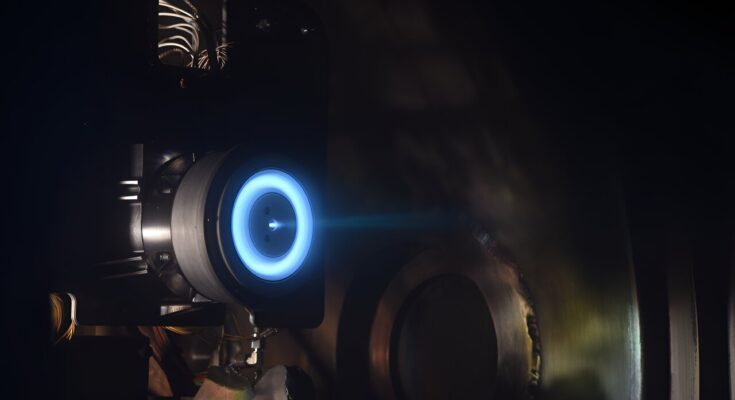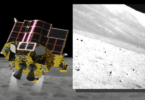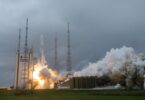Northrop Grumman NGHT-1X engineering prototype Hall-effect thruster operating at Glenn Research Center Vacuum Facility 8. The NGHT-1X design is based on the NASA-H71M Hall-effect thruster. Credit: Northrop Grumman
NASA has developed advanced planetary navigation technology to facilitate future planetary exploration missions using small spacecraft. Not only will this technology enable new types of planetary science missions, one of NASA’s commercial partners is already preparing to use it for another purpose—extending the lifespan of other spacecraft they are rotating.
Identifying the potential for industry to use this new technology not only furthers NASA’s mission of commercializing the technology, it could open the way for NASA to acquire this valuable technology from industry for use in future interplanetary missions.
New technology
Planetary science missions using small spacecraft will be required to perform challenging planetary maneuvers – such as achieving planetary escape velocity, orbit capture, and others – that require a change in velocity ( delta-v) well above normal business requirements and current conditions. – radio. Therefore, the #1 technology enabling the missions of these small spacecraft is a propulsion system that can utilize these high delta-v motions.
The propulsion system must operate at low power (sub-kilowatt) and have high propellant efficiency (ie, the ability to use a large amount of propellant during its lifetime) to enable the motivation needed to carry out these movements.
After many years of research and development, researchers at the NASA Glenn Research Center (GRC) have created a small space electric propulsion system to meet these requirements – the NASA-H71M sub-kilowatt Hall-effect thruster. Furthermore, the successful commercialization of this new accelerator will soon provide at least one such solution to enable the next generation of flight science missions requiring up to 8 km/s of delta-v e amazing
This technical work was achieved by reducing many of the advanced high-energy solar energy technologies that have been developed over the past decade for applications such as the Power and Propulsion Element of Gateway, the facility the first human spaceship to orbit the moon.
Advantages of this technology for planetary exploration
The small spacecraft using NASA-H71M electric technology will be able to drive itself from low-Earth orbit (LEO) to the moon or from geosynchronous transfer orbit (GTO) to Mars.
This capability is particularly impressive because commercial launch opportunities in LEO and GTO have become the norm, and most of the power to launch such missions is often sold at low cost to use secondary space. The ability to perform missions from these near-Earth systems could greatly increase the volume and lower the cost of monthly scientific missions to Mars.
This propulsion capability will increase the reach of secondary spacecraft, which have historically been limited to scientific targets aligned with the launch path of the primary mission. This new technology will enable secondary tasks to deviate from the main project path, which will help to evaluate scientific goals.
× shut up
Left: NASA-H71M Hall-effect thruster at the Glenn Research Center Vacuum Facility 8 thrust stand. Right: Dr. Jonathan Mackey prepares the stage before shutting down and pumping out the test center. Credit: NASA
Additionally, these two space science missions would have only a short period of time to collect data during the high-speed flight of the distant body. This powerful propulsive capability will allow deceleration and orbital insertion of planetoids for long-term scientific exploration.
Additionally, smaller spacecraft with such significant acceleration capabilities will be better equipped to handle late-stage changes to the main mission’s launch trajectory. Such changes are often a major risk for spacecraft science missions with limited acceleration capabilities that depend on the launch system to achieve their scientific goals.
Business tools
The megaconstellations of small spacecraft already orbiting the low Earth have made the low-power Hall-effect the most abundant electrical system in use in space today. These systems use propellant with great efficiency, allowing for insertion into orbit, de-orbiting, and many years of collision avoidance and re-distribution.
However, the cost-effective design of these commercial power systems inevitably limits their lifetime capabilities to less than a few thousand hours of operation and applications these can only work with 10% or less of the original weight of the small spacecraft in propellant.
On the other hand, planetary science missions that benefit from the technology of the NASA-H71M power system can work for 15,000 hours and use more than 30% of the initial weight of the small spacecraft with propellant.
This game-changing capability exceeds the needs of many commercial LEO missions, and comes at a price that makes it a bargain for such applications. Therefore, NASA has sought and continues to seek cooperation with companies that develop ideas for small commercial space missions with unusually large operational requirements.
Another partner that will soon use NASA’s licensed technology for small commercial spacecraft is SpaceLogistics, a division of Northrop Grumman. The satellite’s Mission Extension Pod (MEP) vehicle is equipped with a pair of Northrop Grumman NGHT-1X Hall-effect thrusters, whose design is based on the NASA-H71M.
The large capacity of the small spacecraft will allow it to reach geosynchronous Earth orbit (GEO) where it will be placed with a larger satellite. Once installed, the MEP will act as a propulsion jet pack to extend the life of the host spacecraft by at least six years.
Northrop Grumman is currently conducting long-term wear testing (LDWT) of the NGHT-1X at GRC’s Vacuum Facility 11 to demonstrate its lifetime operational capability. LDWT is funded by Northrop Grumman through a fully reimbursable Local Law Agreement. The first MEP flight is expected to launch in 2025, where it will extend the life of three GEO communications satellites.
Collaborating with US industry to find small space applications with critical requirements similar to NASA’s future planetary science missions not only supports US industry to stay and a world leader in commercial space applications but creating new business opportunities for NASA to acquire these critical technologies as planetary missions require. .
NASA is continuing to develop the H71M’s power technology to expand the range of data and documentation available to US industry with the goal of creating advanced and highly efficient low-power systems. .
#Pushing #boundaries #subkilowatt #electric #propulsion #technology #space #mission #concepts






